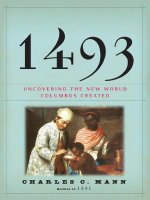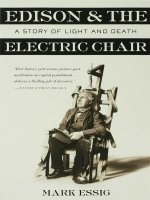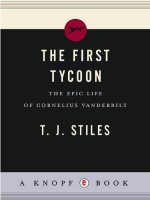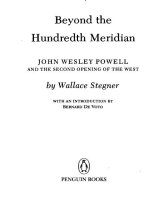Mark essig edison and the electric chair ath (v5 0)
Bạn đang xem bản rút gọn của tài liệu. Xem và tải ngay bản đầy đủ của tài liệu tại đây (9.14 MB, 275 trang )
Edison & the Electric Chair
Edison &
the
Electric
Chair
A Story of Light and Death
Mark Essig
Copyright © 2003 by Mark Essig
All rights reserved. No part of this book may be reproduced or transmitted in any form or by any means, electronic or mechanical,
including photocopying, recording, or by any information storage and retrieval system, without permission in writing from the Publisher.
First published in the United States of America in 2003 by
Walker Publishing Company, Inc. First paperback edition published in 2005.
For information about permission to reproduce selections from this book, write to Permissions, Walker & Company, 104 Fifth Avenue,
New York, New York 10011
Library of Congress Cataloging-in-Publication Data
Essig, Mark Regan, 1969Edison & the electric chair : a story of light and death / Mark Essig.
p. cm.
Includes bibliographical references and index.
eISBN: 978-0-802-71928-7
1. Electrocution—United States—History. 2. Edison, Thomas A. (Thomas Alva), 1847-1931. I. Title: Edison and the electric
chair. II. Title.
HV8696.E87 2003
364.66—dc21
ISBN 0-8027-7710-4 (paperback)
Book design by Ralph L. Fowler
Illustrations by Martie Holmer
Book composition by Coghill Composition Company
Visit Walker & Company's Web site at www.walkerbooks.com
Printed in the United States of America
10 9 8 7 6 5 4 3 2 1
2003052507
TO MY PARENTS,
DOROTHY AND JOHN ESSIG
CONTENTS
PROLOGUE
Edison on the Witness Stand
CHAPTER 1
Early Sparks
CHAPTER 2
The Inventor
CHAPTER 3
Light
CHAPTER 4
Electricity and Life
CHAPTER 5
"Down to the Last Penny"
CHAPTER 6
Wiring New York
CHAPTER 7
The Hanging Ritual
CHAPTER 8
The Death Penalty Commission
CHAPTER 9
George Westinghouse and the Rise of Alternating Current
CHAPTER 10
The Electrical Execution Law
CHAPTER 11
"A Desperate Fight"
CHAPTER 12
"Criminal Economy"
CHAPTER 13
Condemned
CHAPTER 14
Showdown
CHAPTER 15
The Unmasking of Harold Brown
CHAPTER 16
Pride and Reputation
CHAPTER 17
The Electric Wire Panic
CHAPTER 18
Designing the Electric Chair
CHAPTER 19
The Conversion of William Kemmler
CHAPTER 20
The First Experiment
CHAPTER 21
After Kemmler
CHAPTER 22
The End of the Battle of the Currents
CHAPTER 23
The Age of the Electric Chair
EPILOGUE
The New Spectacle of Death
ACKNOWLEDGMENTS
NOTES
ART CREDITS
INDEX
Edison & the Electric Chair
PROLOGUE
Edison on
the Witness Stand
MR. EDISON, what is your calling—your profession?"
"Inventor."
"Have you devoted a good deal of attention to the subject of electricity?"
The hearing room erupted in laughter. It was a standard lawyer's question, intended to establish the
qualifications of an expert witness, but it was hardly necessary in this instance. The men who packed
the room—lawyers, electricians, doctors, and assorted gawkers—knew very well the qualifications
of the man on the stand. In 1879 Thomas Edison had invented the first practical incandescent lamp—
the light-bulb—and over the next decade he carried his light into homes and offices around the world.
As the world's most celebrated electrical authority, Edison clearly had "devoted a good deal of
attention to the subject of electricity."
The inventor took the question in stride. "Yes, sir," he replied.
The date was July 23,1889, and the lawyer asking the questions was William Poste, deputy attorney
general of New York State. Edison was forty-two years old, his dark hair streaked with white, face
smooth-shaven, gray eyes sparkling. In his black suit and white tie, Edison had the aspect, one
reporter remarked, of "a benignant clergyman of middle age." No stranger to the American legal
system, he sat thoroughly at ease in the witness chair. Inventing was a cutthroat business, and Edison
spent a great deal of time dealing with lawyers—suing other companies for stealing his patents,
getting sued in turn for stealing theirs. Invention, he might have said, was 1 percent inspiration and 99
percent litigation.1
The hearing on this day in July, though, was not concerned with patents. It had to do with a murder
case.
"What amount of electrical energy," Poste continued, "do you think would be sufficient to produce
instant, painless, death in all cases?"
"One thousand volts," Edison said.
"What experiments have you observed in your laboratory bearing upon that question?"
"Only of horses and dogs."
Edison referred to a series of tests that had taken place over the previous year at his New Jersey
laboratory. The inventor's assistants attached electrodes to dogs—about two dozen in all, bought at a
quarter a head from neighborhood boys—and killed them with powerful jolts of electricity. Six
calves and two horses also died in the experiments.
"Now, Mr. Edison," the attorney said, "in your opinion, can an electrical current be applied to the
human body by artificial means in such a manner as to produce death in every case?"
"Yes, sir."
"Instant death?"
"Yes, sir."
"Painless?"
"Yes, sir."2
A year and a half earlier New York State had abolished hanging and decreed that condemned
criminals would be executed with electricity. The first murderer condemned under the new law filed
an appeal, claiming that electrical execution was a cruel and unusual punishment and therefore
unconstitutional. A judge ordered hearings to collect expert testimony on the matter, and Edison
agreed to testify in support of the new method.
Electricity had long been considered a mysterious, miraculous force—telegraph operators sent it
zipping along slender copper wires, showmen amused fairgoers by giving them mild electric shocks,
and doctors claimed that the current could cure illness and revive victims of drowning or suffocation.
It had even been used to kill: In the 1750s Benjamin Franklin slaughtered chickens and turkeys with
static electricity.
But using electricity to execute criminals was unprecedented. One newspaper declared that state
officials had been swept up in an electrical craze and were "merely endeavoring to show that there
was no end to the wonders of electricity."3
Although in 1887 Edison had said he would "join heartily in an effort to totally abolish capital
punishment," a year later he became the most powerful advocate of this new method of scientific
killing. Like other defenders of the electrical execution law, he claimed that a powerful current would
be far more humane than hanging.4
Edison's critics, however, believed there was more to the story. In the hallways outside the hearing
room and in the pages of newspapers and electrical journals, insiders alleged that Edison's support
for electrocution was motivated by a devious scheme to gain control of the electrical industry; that an
Edison competitor was spending tens of thousands of dollars to defeat the electrocution law and foil
Edison's plans; that the convicted murderer whose life was on the line had become a pawn in a bitter
industrial struggle.5
If any of these rumors were true, Edison did not let on. Killing with electricity was simply "a good
idea," he said. "It will be so lightning like quick that the criminal can't suffer much."6
CHAPTER 1
Early Sparks
THE ANCIENT GREEKS were the first to record the observation that amber, after being rubbed,
attracted bits of straw or cloth. Around 1600 the Englishman William Gilbert noted that materials
such as diamond and glass shared amber's attractive qualities. He coined a new word, electric, based
on elektron, Greek for amber. An electric was a substance that, when rubbed, drew light objects to
itself; electricity was the property shared by these substances.1
After Gilbert the study of electricity languished for a century or so until it was taken up by members
of London's Royal Society, a new association devoted to the study of the natural world. Using hollow
glass tubes thirty inches long and one inch in diameter, Royal Society members produced the strongest
electrical effects ever witnessed. In 1729 Stephen Gray, an experimenter with the society, corked the
ends of his tube to keep dust from being sucked inside. After rubbing the glass, he noticed to his
surprise that feathers were attracted to the cork as well as to the glass. The "attractive Virtue," as he
put it, had been "communicated" from the glass to the cork. Curious to see how far this communication
would extend, Gray attached ordinary thread to the cork, tied a shilling to the string, and found that the
coin attracted feathers. He extended the string and tied on more objects—a piece of tin, an iron poker,
a copper teakettle, various vegetables—and found that all became electrified. Gray attached thirtytwo feet of thread to the corked end of the glass tube, tied a billiard ball to the other end of the string,
and dangled it out a window. When he rubbed the glass, he found that the billiard ball still proved
attractive.
Abandoning a plan to drop a string from the cupola of St. Paul's Cathedral, Gray decided to
proceed horizontally. He snaked a long piece of iron wire along the ceiling of his workroom,
suspending it from the beams with pieces of string. When he touched the wire with the rubbed glass
wand, however, the attractive virtue did not communicate to the far end. Gray thought the string
suspenders might be too thick, so he tried silk, which worked beautifully. Equally thin brass,
however, failed, leading Gray to conclude that success depended upon the supports "being Silk, and
not upon their being small." The differences between silk and brass wire raised the question of which
objects could be supports and which receivers. (Before long another experimenter started calling
these two classes conductors and insulators.) To test the electrical properties of the human body,
Gray persuaded an orphan boy to allow himself to be suspended horizontally from the ceiling,
supported at his chest and thighs by stout loops of silk. Gray rubbed his glass tube, touched it to the
lad's feet, and found that he attracted feathers to his fingers.2
Philosophers at the time believed that electricity—as well as light, heat, and magnetism—consisted
of exquisitely fine "fluids" that passed through ordinary matter. The electrical phenomena of attraction
and repulsion were thought to be caused by jets of subtle fluids blowing into and out of tiny pores in
larger objects. The public, however, was less concerned with theories of electricity than with the
thrilling effects it produced. Members of polite society in the eighteenth century flocked to scientific
lecture-demonstrations, where they learned about planetary motion, the shape of the Earth, and the
size of the solar system. Newtonian physics could be a bit dull, but a suspended human body
attracting objects to its fingers—that was magic. Electrical displays swept Europe in the 1740s, and a
French entrepreneur sold electrical kits that included a glass wand for rubbing, light objects for
attracting, and thick silk cords for hanging human conductors. In darkened rooms lecturers drew
sparks—"electrical fire"—from the noses of suspended men.
In the electrical craze of the 1740s, "human conductors" were sometimes suspended from the ceiling by silk cords and charged with
electricity.
Experimenters in Germany produced more flamboyant effects. They replaced the glass wand with a
spinning globe and used a "rubber" of leather or paper to excite it. They also suspended prime
conductors—usually a sword or gun barrel—near the globe to collect the charge. Experimenters
were soon killing flies with shocks from their fingers and showcasing the "Venus electrificata," a
woman whose kisses threw sparks. When a glass of brandy was lifted toward the lips of a charged
man, the spark from his nose set the liquor aflame.3
Human conductors began to complain that these shocks were unpleasant, but they did not know true
pain until they experienced another new device. In 1746 Pieter van Musschenbroek of the University
of Leyden attempted to produce electricity with a glass globe and then store it in a jar of water. He
attached a wire to the gun barrel that served as his prime conductor and placed the wire's end in a
water-filled glass jar. While an assistant spun and rubbed the glass globe, Musschenbroek held the
water jar in his hand and reached toward the gun barrel. The shock knocked him to the floor.
Unwittingly, he had invented what became known as the Leyden jar, which could build up charges of
remarkable strength. One experimenter used the jar to knock children off their feet, and another
reported that his wife could not walk for a time after being shocked. The discharge (a new word
coined to describe the Leyden jar shock) could be communicated through several people. In France,
to amuse the king, a powerful Leyden jar was discharged first through a circle of 140 courtiers, then
through 180 gendarmes. Two hundred Cistercians felt the jolt in their Paris monastery and leaped
toward the heavens in unison. The experimenters found they could make the shocks even more
powerful by linking several jars to form a battery. One man wrote, "Would it not be a fatal surprise
to the first experimenter who found a way to intensify electricity to an artificial lightning, and fell a
martyr to his curiosity?"4
ATMOSPHERIC LIGHTNING—the type that shot from the heavens—posed greater dangers and
provoked nearly as much curiosity. According to prevailing theories, lightning resulted from colliding
clouds or some unknown chemical reaction in the atmosphere, but no one knew for sure what it was.
A few believed that it was composed of electrical fluid—the spark and crackle of electricity made
the connection obvious—but this theory had not been proved. Inspired by an itinerant lecturer, the
Philadelphia printer Benjamin Franklin began experimenting with electricity in 1745. A few years
later he proposed an experiment to "determine the Question, Whether the Clouds that contain
Lightning are electrified or not." He attached a silk handle to the end of a kite string and tied a key
where silk and string met. Standing in a doorway to keep himself and the silk dry, he flew the kite into
a "Thunder Gust." Electricity tingled down the wet string, and Franklin drew sparks from the key first
with his knuckle, then with his tongue.5*
Many experimenters in Europe tried variations on Franklin's experiment. Most survived the
dangerous test unscathed, either through dumb luck or because they carefully insulated themselves
from the lightning. In 1753, however, Georg Wilhelm Richmann, a German working in St. Petersburg,
drew a bolt directly through his body. He became the first man to sacrifice his life in the pursuit of
electrical knowledge.6
Franklin himself knew something about death from electricity. Not long after he proposed his
famous lightning experiment, he informed a friend that the discharge from a battery of two Leyden jars
was "sufficient to kill common Hens outright." The birds died so quickly, he said, that
"compassionate persons" might adopt it as a method of killing. Butchers could build a battery of six
Leyden jars, link the battery to a chain, wrap the chain around the thighs of a turkey, and lift the bird
until its head touched the prime conductor. "The animal dies instantly," Franklin wrote. He warned
experimenters to be cautious. While killing turkeys, he accidentally administered the shock to
himself: "It seem'd an universal Blow from head to foot throughout the Body. . . . My Arms and Back
of my Neck felt somewhat numb the remainder of the Evening, and my Breastbone was sore for a
Week after, [as] if it had been bruiz'd. What the Consequence would be, if such a Shock were taken
thro' the Head, I know not." But electrical slaughter, Franklin averred, was worth the danger: "I
conceit that the Birds kill'd in this Manner eat uncommonly tender."7
FRANKLIN ALSO GAVE Leyden jar shocks to people in an attempt to cure them of paralysis. Like
others caught up in the electrical mania of the mid-eighteenth century, he believed that the remarkable
new force could be used as a medical therapy. John Wesley, the founder of Methodism, was one of
England's strongest advocates of electrical cures. Some physicians sealed a drug inside a glass wand,
electrified it, and applied sparks to patients, claiming that the essence of the medicine penetrated the
body along with the subtle electrical fluid. Although physicians sold electricity as a panacea capable
of curing everything from constipation to venereal diseases to hysteria, most, like Franklin, focused
on paralysis. Victims of the Leyden jar reported that the shocks made their muscles contract, and
doctors claimed that electricity could restore paralyzed limbs.8
Electricity's ability to contract muscles also caught the attention of physiologists. A popular theory
at the time held that the brain produced subtle "animal spirits" that were carried by the nerves to
move the muscles of the body. Once it was found that electricity caused muscle contraction, some
proposed that electrical fluid and animal spirits were one and the same—that electricity was the
natural substance coursing through the nerves of animals.
In the 1780s the Bolognese physiologist Luigi Galvani was testing the effects of electricity on
muscles. When he ran brass hooks through frog legs and hung them on an iron railing, he was
surprised to see that the legs contracted spontaneously, without any application of the spark. He found
that he could induce contractions by touching the frog leg in two places with different metals. Galvani
supposed that the frog leg was a miniature Leyden jar, which he was discharging by the touch of two
pieces of metal. Since there was no external source of electricity, the jolt must have come from within
the frog leg—it was "animal electricity," he said, created and stored in muscle tissue.9
Galvani's results, published in 1791, did not convince everyone. Alessandro Volta, a professor of
physics, claimed that the electricity that contracted Galvani's frog leg arose not within the leg itself
but from the contact of brass hook and iron railing. This statement itself was controversial. All known
electricity was created by rubbing glass or other insulators; Volta claimed that he could create
electricity simply by bringing two different metals into contact. Volta convinced few people of this
new theory of electrical generation until he created a device to demonstrate his point. He stacked
multiple pairs of silver and zinc disks, placing a piece of wet cardboard between each pair. This
electrical column, or pile, multiplied the effects of the individual pairs of disks and, when touched at
either end, produced a palpable shock. Volta built a pile of forty pairs and gave himself a jolt through
the ears: "The disagreeable sensation, and which I apprehended might be dangerous, of the shock in
the brain, prevented me from repeating this experiment."10
The voltaic pile, created to quash the notion of animal electricity, had effects Volta never imagined.
The pile could be used to charge Leyn den jars, which confirmed that this new electricity was similar
to that produced by rubbing glass. But there were crucial differences. Previously, all electricity had
been what is now called static—the buildup of a charge, followed by its transitory discharge. The
pile created an electric current that flowed indefinitely and could be made stronger by adding more
pairs of metal disks.
Volta's pile, described in a letter to London's Royal Society in 1800, set off a frenzy of
experimentation. One man built a battery from two types of silverware, although it was more common
to pair silver half crowns with zinc disks. By summer experimenters reported that when they attached
two wires to a pile and ran the "galvanic current" through water, hydrogen bubbles formed on one
electrode while oxygen formed a compound with the metal of the other electrode. The current, in
other words, had decomposed water into its component parts, and the science of electrochemistry
was born. Humphry Davy, a professor of chemistry at the Royal Institution in London, ran the current
through two common substances—potash and soda—and produced tiny globules of previously
unknown metals, which were named potassium and sodium.
Davy's prestige in London rested as much on his skills as a popular lecturer as on his scientific
discoveries. Though important to science, electrochemistry offered little drama in the lecture hall, so
Davy found ways to please his audience. In an 1809 demonstration he ran the current from a powerful
battery across a small gap between two carbon rods. As the current jumped the gap, it created a
brilliant, arc-shaped, blue-white light that flooded the lecture hall and astonished the crowd.11
DAVY HAD INVENTED what came to be known as the arc light. At the time it had few practical
applications, since batteries powerful enough to produce the effect consumed large amounts of rare
metals-silver, copper, zinc—and were therefore enormously expensive. Around 1830, however,
scientists discovered a new way to produce electricity. Michael Faraday, who started his scientific
career as Davy's assistant, became intrigued by a report that an electric current caused movement in a
nearby compass needle. This suggested that electricity produced magnetism. Faraday wondered if the
reverse was true—whether magnetism could produce electricity. In 1831 he showed that rotating a
coil of conducting wire within the lines of force of a magnetic field caused a current to flow in the
wire. Following Farada/s lead, instrument makers in France created the first magneto-electric
generators (often shortened to magnetos), hand-cranked machines that spun coils of wire relative to
magnetic fields, creating electrical current.
The coils of conducting wire in a generator were known as an armature. As figure 1 shows, when
the armature was in the first half of its rotation, the current moved along the conductor in one
direction, from point A to point B. But in the second half of the turn, the relationship between the coil
and the north and south poles of the magnet was reversed, causing the current to flow from point B to
point A. For every 360-degree turn of the coil, the current changed direction twice: from A-B to B-A,
then back again. This became known as intermittent—or alternating—current.
Figure 1: First half of rotation (left): When part of the armature cuts the magnetic lines of force near the magnet's north pole, current
moves up the wire and produces a positive charge at the lower slip ring. The current is transferred from the slip rings through the
brushes and flows through the outside circuit in a clockwise direction. Second half of rotation (right): The same part of the armature now
cuts the lines of force near the south pole, causing current to move down the wire and producing a negative charge at the lower slip
ring, reversing the current flow. The frequency of current reversal depends on the speed at which the coil rotates.
Electricity so produced behaved differently from battery current, which flowed continuously in one
direction. Electrochemistry-decomposing water or isolating sodium from soda, for instance-depended
on one electrode remaining positive and the other negative. The same was true for electroplating, in
which a brass object such as a spoon was placed in a solution of potassium cyanide in which gold
had been dissolved. When an electric current was run through the solution, the spoon—which served
as the negative electrode—became coated with a layer of gold. Electroplating and electrochemistry
required continuous current, because the processes did not work if each electrode was alternately
positive and negative, as was the case with alternating current. Magnetos created a form of electricity
that appeared to be unusable.
To solve this problem, instrument makers developed a way to transform the alternating current from
a generator into continuous—or direct—current, like that from a battery. This change was
accomplished with a switching device called a commutator, which kept the current in the outside
circuit flowing in one direction only.12
Direct-current generators proved useful for laboratory demonstrations and electroplating, but the
one large mid-nineteenth-century industry that relied on electricity—telegraphy—stuck with batteries,
which provided a steadier current. In the late 1830s electric telegraph systems were developed in
England by W. F. Cooke and Charles Wheatstone and in the United States by Samuel F. B. Morse. In
Morse's system, the transmitter consisted of a simple key that opened and closed a circuit,
transmitting pulses of electricity that conveyed a message via a dot-dash code. At the receiving end,
the electricity caused movement in a magnetic device attached to a pencil, which recorded dots and
dashes on paper tape. These paper tape receivers soon were replaced by sounders, devices that
translated the arriving pulses into clicking noises. Rather than decoding the message after the dots and
dashes were printed on paper, operators listened to the coded clicks and transcribed on the fly.13
Morse built an experimental line from Baltimore to Washington, D.C., and on May 24, 1844,
transmitted his telegraph's inaugural message—"What hath God wrought!" His next transmission
—"Have you any news?"—proved prophetic, as within a few years a torrent of information gushed
down the slender copper wires. Whereas all previous long-distance communication depended on
transportation-horses, ships, or trains carrying words on paper—the telegraph carried messages at the
blazing speed of electricity. Newspapers, ever eager to scoop their rivals, were quick to embrace the
technology, as were railways. Trains dispatched according to timetables tended to get off schedule
and collide with each other; telegraphs allowed railroad managers to coordinate traffic safely.
Telegraph lines followed railroad rights-of-way, and the two technologies advanced in tandem,
copper wires stretched out alongside iron rails.14
At the end of the Civil War the Western Union Telegraph Company, the industry leader, owned
more than 44,000 miles of telegraph wire, more than the combined total of its two strongest rivals,
American Telegraph and U.S. Telegraph. At that time long-distance transmission between cities
remained the core of the industry, but new telegraph-based services began springing up rapidly—
most notably, fire alarm call boxes on city streets that allowed citizens to report the location of fires,
and stock and gold quotation systems that linked banks and brokerage houses with central exchanges.
Competition was fierce in the young industry, and companies were eager to gain an edge through
technical innovation. The situation created rich opportunities for ambitious young inventors.15
* Although Franklin was the first to propose this type of experiment, he was not the first to perform it.
He described a lightning experiment in a letter published in England in 1751. In May 1752 French
experimenters followed his instructions and confirmed that lightning was electrical in nature. A month
or so later—probably before he had heard of the French success—Franklin flew his kite into the
storm.
CHAPTER 2
The Inventor
THOMAS ALVA EDISON began his working life in i860, at the age of thirteen, when he took a
job as a "news butch" selling newspapers and candy on the Grand Trunk Railway that ran between
Detroit and his home in Port Huron, Michigan. The job did not pay well, but he found ways to
supplement his income. On April 6,1862, the Detroit Free Press was filled with news of the Civil
War battle at Shiloh. Before the train started its return trip to Port Huron, Edison acquired 1,000
instead of his usual 100 papers and bribed a telegraph operator to wire news of the battle to stations
along the line. At each stop the train was greeted by crowds of men eager for details of the battle, and
Edison made a small fortune selling copies of the Free Press at five times the usual price.
Even as a boy, Edison displayed the skills that would serve him well for the rest of his life: an eye
for the main chance, a knack for publicity, and a grasp of the possibilities of the latest technology.1
The young Edison—Alva to his mother, Al to his friends—never received much formal education.
Born in February 1847, he spent the first seven years of his life in Milan, Ohio, before his father, a
shingle maker, moved the family to Port Huron, where he attended school for less than a year.
"Teachers told us to keep him in the streets, for he would never make a scholar," Edison's father
reported. "Some folks thought he was a little addled." Edison's mother taught him to read at home.2
The Grand Trunk left Port Huron each morning at seven and arrived about four hours later in
Detroit, where it stopped over until the return journey started in the evening. To fill the long
afternoons, Edison joined the Detroit Young Men's Society and pored over the science books in its
library. After reading a chemistry text, he bought chemicals, crucibles, and beakers, installed a
laboratory in the train's baggage car, and spent many happy hours experimenting—until a broken
bottle of phosphorus set the car on fire, and the enraged baggage master dumped the boy's laboratory
onto the tracks. Edison later recalled that the baggage master "boxed my ears so severely that I got
somewhat deaf thereafter." (Hearing problems would plague him for the rest of his life.)3
Seeking other outlets for his curiosity, Edison practiced on the equipment at railway telegraph
offices. In 1862 he plucked a small boy from the path of a rolling freight car, and the boy's father, a
telegraph operator, gave Edison formal telegraph lessons as a reward. His training complete, he left
home at age sixteen to become a "tramp" telegrapher, moving from city to city in search of new jobs
and new experiences. Between 1863 and 1868 he lived in Ontario, Toledo, Indianapolis, Cincinnati,
Memphis, Louisville, and New Orleans.4
Edison at the age of fourteen, when he worked as a "news butch" on the Grand Trunk Railway in Michigan.
Within the hard-drinking, hard-living fraternity of tramp telegraphers, Edison stood apart. Not
content to listen and transcribe, he wanted to understand the principles underlying the devices he used
each day. While other men avoided night shifts as an impediment to carousing, Edison embraced them
because they left his days open for experimenting on equipment and reading technical journals and
books (one of his favorites was Michael Faraday's Researches in Electricity). Even Edison's
amusements were scientific. At one point he and a friend acquired a device called an induction coil
—which transformed low voltages from an electric battery into painful shocks—and wired it to the
metal sink in a railroad roundhouse. As unwitting victims touched the sink, they shouted and jumped
into the air. "We enjoyed the sport immensely," Edison said.5
In 1868 Edison landed a job with Western Union in Boston and appeared for his first day of work
dressed in a blue flannel shirt, jeans, a wrinkled jacket, and a hat with a torn brim. The finely dressed
Boston operators, amused by his rough appearance, took to calling him "the Looney" and hatched a
plan to haze him. On his first shift, he was asked to receive press copy from New York. The New
York operator, who was in on the plot, began to transmit at the rapid clip of twenty-five words per
minute, but Edison kept pace easily. When the speed increased to a dizzying thirty, then thirty-five
words per minute, Edison still did not waver. Finally, when the New York operator began to skip and
abbreviate words, Edison was forced to break. He tapped a message down the wire to New York:
"You seem to be tired, suppose you send a while with your other foot." The Boston operators burst
into laughter. The episode "saved me," Edison said. "After this, I was all right with the other
operators."6
Despite his receiving skills, Edison was less interested in operating than in experimenting with the
equipment. At the time, Boston was second only to New York as a center of telegraphy in the United
States. Using contacts forged during his years as an operator, Edison found investors willing to fund
his experiments on telegraph printers, fire alarm systems, and a vote recorder. The last device—for
tallying votes in legislative houses—never found a market, but it was historic nonetheless: It became
Edison's first patented invention, U.S. Patent 90,646, issued June 1, 1869. The lawyer who filed this
patent application for Edison described the young inventor as "uncouth in manner, a chewer rather
than a smoker of tobacco, but full of intelligence and ideas." With a couple of partners Edison started
a business providing gold and stock quotations for banks and brokerage houses. Buoyed by initial
success, he quit his job with Western Union and in January 1869 placed a notice in the journal
Telegrapher announcing that he would now "devote his time to bringing out inventions."7
Within a few months of this announcement, he withdrew from the Boston enterprise and moved to
New York, where he formed a partnership with Franklin Pope, a prominent expert in telegraphy, and
James Ashley, an editor of Telegrapher. By the end of 1870, the three had developed a telegraph
printer and sold the rights to it for $15,000 (roughly the equivalent of $250,000 today). Shortly after
the sale, the partnership split apart on bitter terms. Edison claimed Ashley and Pope tried to cheat
him out of money, while they accused Edison of violating the partnership agreement by striking his
own deals with manufacturers.8
The rift did not slow Edison's career. After the quick success of the printer, his inventing skills
were in high demand. He signed contracts to develop inventions for several telegraph firms and, with
the money they provided, opened a laboratory and manufacturing operation in Newark that employed
more than forty-five hands. (In a letter to his parents back in Michigan, he described himself as a
"Bloated Eastern Manufacturer.") A telegraphic news service he started failed after a few months, but
it proved important nonetheless: The twenty-four-year-old Edison courted one of the company's
employees—Mary Stil-well, age sixteen—and married her on Christmas Day 1871. 9
The main financial backer of Edison's Newark shops was the Gold & Stock Telegraph Company,
for whom he developed the Universal stock printer, a device that became the industry standard,
ticking out stock prices in brokers' offices all around the world. When Western Union bought control
of Gold & Stock in 1871, Edison came under the wing of the industry giant. Western Union was
particularly eager to finance Edison's research into duplex telegraphy, which allowed two messages
to be sent simultaneously on the same wire, one in each direction. The company expected Edison
simply to refine existing duplex technology, but Edison developed something revolutionary: the
quadruplex telegraph, which allowed simultaneous transmission of two signals in each direction over
one wire. By doubling the capacity of its wires, the quadruplex promised to save Western Union a
great deal of money by limiting its biggest cash drain, the need to build and maintain wires. After
Edison perfected his quadruplex and patented it, Western Union gave him a $5,000 advance payment
and opened negotiations for purchase of full rights.10
Although Western Union had funded Edison's research, he had never signed a formal contract with
the company. When the company was slow in coming to terms, the inventor therefore felt free to
entertain an offer from Jay Gould. A notorious financier who had nearly cornered the gold market a
few years earlier, Gould now wanted to challenge Western Union for control of the long-distance
telegraph industry, and Edison's quadruplex was the key to his plan. When Western Union finally
tendered a firm offer to Edison in January 1875, it was shocked to learn that the rights were no longer
available; two weeks earlier Edison had sold out to Gould's company, Atlantic & Pacific, for
$30,000. Western Union's president remarked that Edison had "a vacuum where his conscience ought
to be."11*
WITH THE MONEY from the quadruplex and his other inventions, in 1876 the twenty-eight-year-old
Edison built himself a new laboratory in the sleepy hamlet of Menlo Park, New Jersey, about twentyfive miles southwest of Manhattan. A few other men operated electrical and telegraphic laboratories
at the time: The inventor Moses Farmer, for instance, worked on telegraphic and other electrical
equipment from a small laboratory in Boston, and Elisha Gray conducted experiments at the shops of
the Western Electric Manufacturing Company. But Edison's early triumphs allowed him to operate on
a different scale. In a two-story frame building in Menlo Park, he built the best laboratory in the
country and hired the most talented mechanics. He called it his "invention factory," and he had such
faith in himself, his men, and his new lab that he predicted "a minor invention every ten days and a
big thing every six months or so."12
R. F. Outcault's illustration of Edison's laboratory complex in Menlo Park, New jersey, as it appeared in 1881. The long building in the
center is the main laboratory.
The first major invention to emerge from Menlo Park was a refined version of the device
Alexander Graham Bell had first unveiled in 1876: the telephone. In Bell's telephone transmitter, the
sound waves of the human voice vibrated a metal diaphragm, which induced an electric 21 current in
an electromagnet. The current traveled over a wire and into a receiver, which essentially was a
transmitter in reverse—an electromagnet vibrated a metal diaphragm, which (at least in theory)
reproduced the original sound. Early users of Bell's telephone found, however, that voices emerging
from the receiver were nearly unintelligible. The problem, Edison discovered, was the transmitter's
electromagnet, which did a poor job of translating sound waves into electric current. Sensing an
opportunity to win a patent on a crucial component of the telephone, Edison began experimenting on
transmitters. He found that by replacing the electromagnet with buttons of compressed carbon, he
could faithfully reproduce the modulations of the human voice. Edison's new carbon transmitter
transformed the telephone from a novelty into a practical means of communication-and soon provided
him with a fresh stream of income.
The telephone work led directly to another invention. At the time, when telephones were still
largely in the experimental stage, no one had imagined a day when the instrument would be in every
home and office, allowing people to speak directly to each other. Edison, like most other observers,
expected that the telephone would function just as the telegraph system did, with an operator
transcribing a voice message and delivering it to the recipient. The electrical pulses of a telegraph
message could be preserved and replayed at a later time; Edison believed a telephone system should
have a similar capability. The goal, as Edison described it in July 1877, was to "store up St
reproduce automatically at any future time the human voice."13
Edison earlier had invented a device to record the electrical impulses of telegraph messages on
waxed paper tape, and he also knew that the human voice created vibrations in the diaphragm of a
telephone transmitter. He decided to see if these vibrations, like the telegraph messages, could be
embossed and repeated. Late in 1877 Edison designed a lathelike machine consisting of a cylinder
wrapped with tinfoil and attached to a hand crank. There were two diaphragms, each attached to a
needle. One needle would emboss the sound waves into the foil; the other, in passing over the
indentations, would reproduce the original sound.
One of the Menlo Park workers built the device to Edison's specifications, and it surprised
everyone by working the first time it was tried. Edison called it the phonograph, or "sound writer."
Edward H. Johnson, a business associate of Edison's since the early 1870s and a master showman,
took charge of promoting the phonograph in public exhibits up and down the East Coast. The concept
was so novel that many people refused to believe it. A Yale professor insisted that the "idea of a
talking machine is ridiculous" and advised Edison to disavow published accounts of the phonograph
in order to protect his "good reputation as an inventor." Many were convinced that Edison was simply
a ventriloquist, throwing his voice into the machine. A visiting minister rapidly shouted a tonguetwisting string of biblical names into the phonograph; only when the machine spit them back precisely
did he believe that Edison had no tricks up his sleeve. On an April 1878 trip to Washington, D.C.,
Edison entertained President Rutherford B. Hayes and his wife with the phonograph until three in the
morning.14
Before he invented the phonograph, Edison was well known to Wall Street and telegraph men.
Afterward, he became one of the most famous men in the world. When reporters flocked to Menlo
Park to interview the creator of this marvelous machine, they were surprised to encounter not a
solemn man of science but a beaming, boyish inventor. Pants baggy and unpressed, vest flying open,
coat stained with grease, hands discolored by acid, Edison "looked like nothing so much as a country
store keeper hurrying to fill an order of prunes." Newspapers described a man who rarely slept and
who appeared to subsist entirely on pie, coffee, chewing tobacco, and cigars. Because of his partial
deafness, which had grown worse since boyhood, Edison's face took on an aspect of gravely serious
concentration when he listened, but when he described his latest inventions in his high-pitched voice,
his gray eyes flashed and his smooth-shaven face lit up with joy. In 1878 the New York Daily Graphic
coined the nickname that would follow him the rest of his life: "the Wizard of Menlo Park." Edison
seemed to be a distillation of America's self-image—unpolished and unpretentious yet gripped by an
ambition to transform the world.15
Edison with his newly invented phonograph. The famed Civil War photographer Mathew Brady took this portrait during Edison's 1878
trip to Washington, D.C.
.
.
.
EDISON CRAVED the public's attention, but it also exhausted him. By the late spring of 1878, he
was tired and ill. He had been working at a frantic pace for more than a year and had not had a
vacation since his honeymoon nearly seven years before. When a friend invited him to join an
expedition traveling to the Wyoming Territory to view a solar eclipse, he jumped at the chance.16
Edison spurned the comforts of the expedition's reserved railroad car and instead spent much of the
journey perched precariously on the cowcatcher, the wedge at the front of the locomotive designed to
pitch cows and other obstacles out of the train's path. Despite its dangers—at one point, Edison later
recalled, "the locomotive struck an animal about the size of a small cub bear, which I think was a
badger," and he barely dodged out of the way—the spot allowed Edison to breathe the clear air of the
West, untroubled by the black smoke billowing from the train's smokestack.17
During the western trip, Edison talked to other scientists about new discoveries in the field of
electric lighting. Edison had toyed with lighting experiments before, but other projects intervened.
Even before his train returned to Menlo Park, he had decided to take up the problem again. Much of









